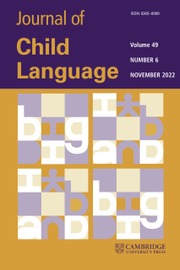Article contents
Cue conflicts in context: interplay between morphosyntax and discourse context in Danish preschoolers' semantic role assignment*
Published online by Cambridge University Press: 19 January 2015
Abstract
When learning their first language, children develop strategies for assigning semantic roles to sentence structures, depending on morphosyntactic cues such as case and word order. Traditionally, comprehension experiments have presented transitive clauses in isolation, and cross-linguistically children have been found to misinterpret object-first constructions by following a word-order strategy (Chan, Lieven & Tomasello, 2009; Dittmar, Abbot-Smith, Lieven & Tomasello, 2008; Hakuta, 1982; McDonald, 1989; Slobin & Bever, 1982). In an act-out study, we replicated this finding with Danish preschoolers. However, object-first clauses may be context-sensitive structures, which are infelicitous in isolation. In a second act-out study we presented OVS clauses in supportive and unsupportive discourse contexts and in isolation and found that five- to six-year-olds' OVS comprehension was enhanced in discourse-pragmatically felicitous contexts. Our results extend previous findings of preschoolers' sensitivity to discourse-contextual cues in sentence comprehension (Hurewitz, 2001; Song & Fisher, 2005) to the basic task of assigning agent and patient roles.
Information
- Type
- Articles
- Information
- Copyright
- Copyright © Cambridge University Press 2015
Footnotes
Many thanks to Katrine Lyskov Jensen for coding reliabilities, and to the Center for Child Language, University of Southern Denmark, for access to their CDS data. Our sincere thanks also go to two anonymous reviewers as well as our action editor at JCL for thorough, inspiring feedback and many valuable suggestions. We are grateful to the children, parents, and teachers in Ellesletten kindergarten for their participation and support.
References
REFERENCES
- 7
- Cited by

